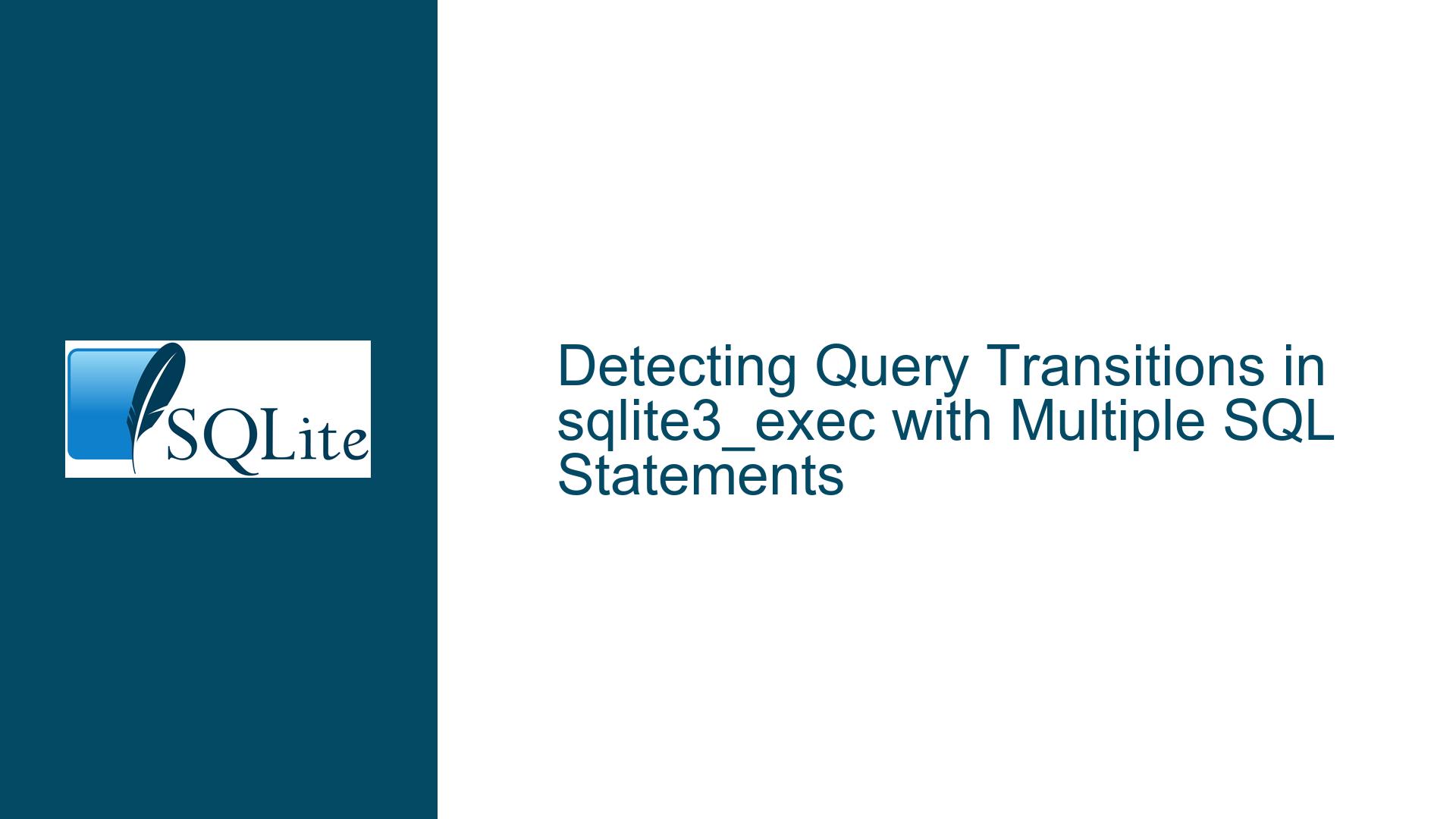Detecting Query Transitions in sqlite3_exec with Multiple SQL Statements
SQLite3_exec Behavior with Multiple SQL Statements
When using sqlite3_exec to execute multiple SQL statements in a single call, developers often face the challenge of determining when one query ends and the next begins. The sqlite3_exec function is designed to execute a string of SQL statements sequentially, but it does not provide a direct mechanism to signal the transition between queries. This behavior can be problematic in scenarios where the application needs to process the results of each query separately, such as in a GUI application that retrieves data for different screens or forms.
The core issue arises because sqlite3_exec treats the entire input string as a single unit of work. It executes each SQL statement in sequence, invoking the provided callback function for each row of the result set. However, the callback function does not receive any explicit information about which query is currently being executed. This lack of context can make it difficult to distinguish between the results of different queries, especially when the queries return similar result sets.
For example, consider the following SQL statements executed via sqlite3_exec:
SELECT * FROM employees WHERE department = 'Sales';
SELECT * FROM employees WHERE department = 'Engineering';
In this case, the callback function will be invoked for each row returned by both queries, but there is no built-in mechanism to indicate whether a row belongs to the "Sales" or "Engineering" query. This ambiguity can complicate the processing of results, particularly when the application needs to group or differentiate data based on the originating query.
Challenges in Tracking Query Transitions Using Column Names or Schema Differences
One common approach to detecting query transitions is to rely on differences in the result set schema, such as changes in column names or the number of columns. For instance, if the first query returns columns id, name, and salary, while the second query returns id, name, and department, the callback function could use these differences to infer the transition between queries. However, this approach has several limitations.
First, it assumes that the queries will return different column names or a different number of columns. In many cases, this assumption may not hold true. For example, consider the following queries:
SELECT * FROM employees WHERE gender = 'M';
SELECT * FROM employees WHERE gender = 'F';
Both queries return the same set of columns, making it impossible to distinguish between them based on schema differences alone. Even if the column names differ, relying on this method can be error-prone, as it requires the application to anticipate all possible schema variations and handle them appropriately.
Second, this approach does not account for queries that return no results. For example, a DROP TABLE statement or a SELECT query with a WHERE clause that evaluates to false will not invoke the callback function at all. In such cases, the application has no way of knowing that a query has been executed, let alone which query it was.
Third, tracking schema differences can become cumbersome in complex applications with many queries. The callback function would need to maintain state information about the expected schema for each query, increasing the complexity of the code and the potential for bugs.
Implementing Sentinel Queries and Separate sqlite3_exec Calls for Query Transition Detection
To address the limitations of schema-based tracking, developers can employ alternative strategies such as using sentinel queries or issuing separate sqlite3_exec calls for each query. These approaches provide more reliable mechanisms for detecting query transitions and processing results.
Sentinel Queries
A sentinel query is a special SQL statement inserted between the actual queries to serve as a marker for query transitions. The sentinel query returns a known result that the callback function can recognize, allowing it to determine when one query ends and the next begins. For example:
SELECT * FROM employees WHERE department = 'Sales';
SELECT 'END-OF-QUERY-1' AS marker;
SELECT * FROM employees WHERE department = 'Engineering';
SELECT 'END-OF-QUERY-2' AS marker;
In this example, the callback function can check for the presence of the marker column and its value to identify the transition between queries. This approach provides a clear and unambiguous signal for query transitions, even when the actual queries return similar or identical result sets.
However, sentinel queries have their own limitations. They require modifying the SQL statement string to include the additional queries, which can be cumbersome and error-prone. Additionally, the sentinel queries must be carefully designed to avoid conflicts with the actual queries, such as using unique column names or values that are unlikely to appear in the data.
Separate sqlite3_exec Calls
Another approach is to issue separate sqlite3_exec calls for each query, rather than executing all queries in a single call. This method ensures that the application has full control over the execution of each query and can process the results independently. For example:
sqlite3_exec(db, "SELECT * FROM employees WHERE department = 'Sales';", callback, NULL, NULL);
sqlite3_exec(db, "SELECT * FROM employees WHERE department = 'Engineering';", callback, NULL, NULL);
By issuing separate calls, the application can easily determine when each query starts and ends, as the callback function will only be invoked for the results of the current query. This approach eliminates the need for complex tracking mechanisms and provides a straightforward way to handle query transitions.
However, this method may not be suitable for all scenarios. Issuing multiple sqlite3_exec calls can increase the overhead of database operations, particularly in applications with a large number of queries. Additionally, it may complicate transaction management, as each sqlite3_exec call operates independently and does not share a transaction context with other calls.
Combining Approaches for Robust Query Transition Detection
In practice, a combination of sentinel queries and separate sqlite3_exec calls may provide the most robust solution for detecting query transitions. For example, the application could use separate sqlite3_exec calls for major query groups and sentinel queries within each group to further refine the transition detection. This hybrid approach balances the benefits of both methods while mitigating their respective limitations.
For instance, consider an application that retrieves employee data for different departments and performs additional filtering based on gender. The application could issue separate sqlite3_exec calls for each department and use sentinel queries to distinguish between gender-based filters within each department:
sqlite3_exec(db, "SELECT * FROM employees WHERE department = 'Sales';", callback, NULL, NULL);
sqlite3_exec(db, "SELECT * FROM employees WHERE department = 'Sales' AND gender = 'M'; SELECT 'END-OF-QUERY' AS marker;", callback, NULL, NULL);
sqlite3_exec(db, "SELECT * FROM employees WHERE department = 'Sales' AND gender = 'F'; SELECT 'END-OF-QUERY' AS marker;", callback, NULL, NULL);
sqlite3_exec(db, "SELECT * FROM employees WHERE department = 'Engineering';", callback, NULL, NULL);
sqlite3_exec(db, "SELECT * FROM employees WHERE department = 'Engineering' AND gender = 'M'; SELECT 'END-OF-QUERY' AS marker;", callback, NULL, NULL);
sqlite3_exec(db, "SELECT * FROM employees WHERE department = 'Engineering' AND gender = 'F'; SELECT 'END-OF-QUERY' AS marker;", callback, NULL, NULL);
This approach ensures that the application can accurately detect query transitions at both the department and gender levels, providing a high degree of control over result processing.
Best Practices for Handling Query Transitions in sqlite3_exec
To effectively handle query transitions in sqlite3_exec, developers should adhere to the following best practices:
Minimize the Use of Multiple Queries in a Single Call: Whenever possible, avoid executing multiple queries in a single
sqlite3_execcall. Instead, issue separate calls for each query to simplify result processing and improve code maintainability.Use Sentinel Queries Judiciously: If multiple queries must be executed in a single call, consider using sentinel queries to mark transitions. Ensure that the sentinel queries are designed to be easily recognizable and do not conflict with the actual queries.
Maintain State in the Callback Function: When using sentinel queries or schema-based tracking, maintain state information in the callback function to track the current query and handle transitions appropriately. This may involve using global variables or passing a user-defined context to the callback function.
Handle Edge Cases: Account for edge cases such as queries that return no results or queries that modify the database schema. Ensure that the application can handle these cases gracefully without losing track of query transitions.
Optimize for Performance: Be mindful of the performance implications of different approaches. For example, issuing multiple
sqlite3_execcalls may increase overhead, while using sentinel queries may require additional processing in the callback function. Choose the approach that best balances performance and maintainability for your specific use case.
By following these best practices, developers can effectively manage query transitions in sqlite3_exec and ensure that their applications process query results accurately and efficiently. Whether using sentinel queries, separate sqlite3_exec calls, or a combination of both, the key is to design a solution that provides clear and reliable indicators of query transitions while minimizing complexity and overhead.






